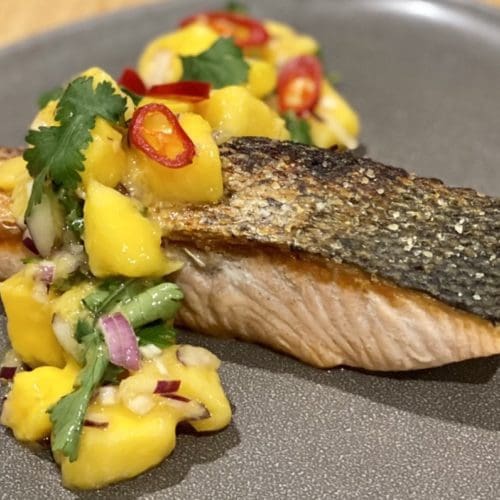
Salmon and Asian mango salsa
This Asian style mango salsa salmon will have your taste buds singing, it's perfect to have on a hot summer day with your favourite cocktail
Ingredients
- 2 salmon fillets (NOTE 1)
- salt and pepper
- oil (NOTE 2)
MANGO SALSA
- 2 mango (chopped) (NOTE 3)
- ½ cup coriander (cilantro) (leaves only)
- ½ red onion (chopped finely)
- 2 chillies (sliced thinly)
- 1 tsp brown sugar
- 1 tbsp fish sauce (NOTE 4)
- 1 lime (juice only)
- salt and pepper
Instructions
- Place the salmon fillets on a cutting board or a plate skin up. Using a paper towel press against the skin to remove any moisture. Leave the salmon to rest for 15 minutes at room temperature.
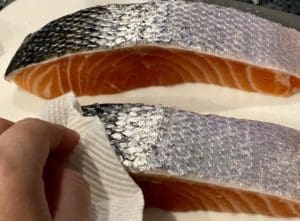
- Meanwhile, make the salsa - In a bowl add in the mango, coriander, chilli and onions. Cover the bowl and place it in the fridge until ready to use. For the dressing, in a small bowl use a teaspoon to dissolve the sugar in the fish sauce and lime juice. Leave the dressing to the side for later use.
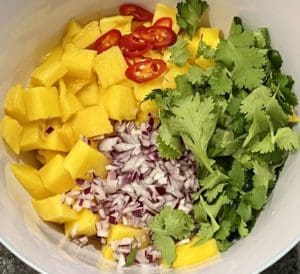
- Just before cooking the salmon use a paper towel once more to remove any moisture of the skin. Turn the salmon and season it with salt and pepper, on the skin side apply a generous amount of salt but no pepper as it will burn.
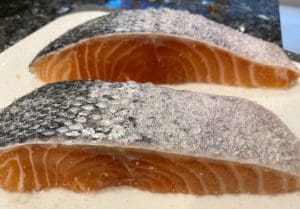
- In a frypan on medium to high heat pour enough to coat the entire base of the pan. Heat up the oil, it will be ready when it sizzles when the salmon touches the oil. Make sure the heat is not too high or it will burn the skin before the salmon is cooked.
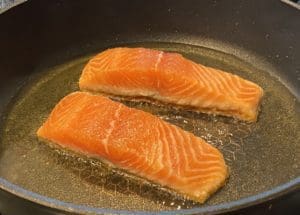
- Carefully place the salmon in the pan skin down and leave to cook on this side for most of the cooking time. You can determine how far the salmon is cooked by looking at the sides of the salmon, you will see it change colour slowly from the skin upwards. As soon as it's cooked to how you prefer to eat your salmon, flip it over and cook the other side for a minute or so.
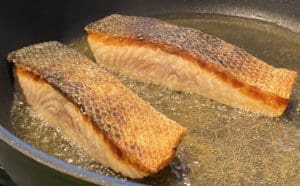
- Finish off the salsa by gently mixing in the dressing with the mango, taste and add seasoning to suit your taste. Lay the salmon down on a plate with the skin facing up and top it with the mango salsa.
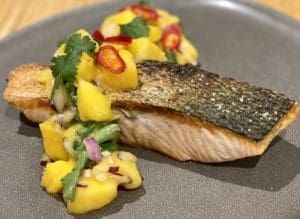
Notes
NOTE 1: Salmon fillets - I prefer to use fresh salmon with skin as I love crispy skin salmon. It's much harder to achieve a crispy skin on frozen salmon due to the moisture content after thawing it. I also prefer the middle part of the salmon rather than the tail because the ends are thinner. This means it's easier to overcook the salmon whilst getting the skin to crisp up during cooking.
NOTE 2: Oil - Use oil that has a high smoke point such as canola, peanut, sunflower or vegetable oil.
NOTE 3: Mangos - The salsa recipe is forgiving so you can use all types and sizes, even the Mangoes that are slightly sour and have not fully ripened.
NOTE 4: Fish sauce - has a very potent fishy aroma but it adds amazing flavour. The small amount used in the salsa does not overpower the other flavours and the smell is less noticeable once everything is mixed in.
This dish tastes wonderful served with rice and a cold glass of white wine.
Nutrition
Serving: 1servingCalories: 532kcalCarbohydrates: 41gProtein: 37gFat: 26gSaturated Fat: 3gCholesterol: 94mgSodium: 1082mgPotassium: 1413mgFiber: 4gSugar: 34gVitamin A: 3006IUVitamin C: 148mgCalcium: 56mgIron: 2mg